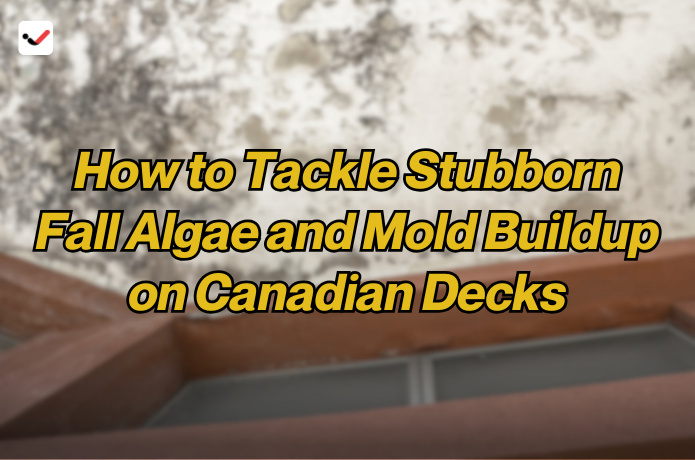How to Tackle Stubborn Fall Algae and Mold Buildup on Canadian Decks
How to Tackle Stubborn Fall Algae and Mold Buildup on Canadian Decks

As the cooler months roll in across Canada, many homeowners start to notice an increase in algae and mold buildup on their decks. Autumn brings damp conditions that provide the ideal environment for these unwanted guests to thrive. With the falling leaves, rain, and sometimes snow, the deck surface stays moist, creating the perfect breeding ground for green algae and black mold. If not treated promptly, these substances can cause staining, create a slippery surface, and even damage the wood over time.
Tackling algae and mold in the fall is essential not only for keeping your deck safe and visually appealing but also for extending its lifespan. Preventive care during this season makes maintenance easier in the long term, as well-kept decks are more resistant to moisture, mold, and mildew. This guide will walk you through the most effective ways to remove and prevent algae and mold buildup on your Canadian deck, ensuring it stays in top shape year-round.
Understanding Algae and Mold on Decks
Mold and algae are types of fungi and plants that thrive in moisture. While algae typically create a green, slimy film, mold often appears as dark spots and can penetrate deeper into the wood. Both can become particularly stubborn in the fall when fallen leaves and cool, damp air create an environment that allows them to spread quickly.
The growth of algae and mold on your deck is not just an aesthetic issue; it can also make surfaces slippery, which poses a risk for slips and falls. Additionally, if mold grows unchecked, it can start to break down the wood fibers, weakening the structure of the deck. Understanding why these growths happen and how to control them is the first step toward maintaining a safe and beautiful outdoor space.
Step 1: Gather the Right Cleaning Supplies
Before you start cleaning, ensure you have the right materials. Using the right supplies is essential for tackling tough algae and mold buildup effectively and safely. Some helpful supplies for deck cleaning include:
A stiff-bristle brush
A garden hose with a spray nozzle
Mild detergent or deck cleaner
White vinegar or a store-bought mold remover
Protective gloves and eyewear
Pressure washer (optional)
Choosing cleaning solutions that won’t damage your deck’s material is crucial. Wood decks require more gentle products compared to composite or plastic materials. If you’re unsure, test a small area first to ensure the cleaner doesn’t discolor or damage the deck surface.
Step 2: Remove Debris Regularly
One of the easiest ways to prevent algae and mold from accumulating on your deck is to keep it clear of debris. Fallen leaves, pine needles, and other organic materials retain moisture, which encourages algae and mold growth. Clearing this debris every few days in the fall can help prevent moisture buildup.
A good tool for this job is a leaf blower, which makes it easy to remove loose debris without damaging the surface. If a leaf blower isn’t available, use a broom or rake to keep the surface clear. Pay special attention to corners and crevices where debris tends to gather and stay damp longer. The less moisture and organic material on your deck, the less likely algae and mold will grow.
Step 3: Apply a DIY or Commercial Deck Cleaner
For a deeper clean, a deck cleaner is highly effective. While there are many commercial products designed specifically for removing algae and mold from outdoor surfaces, a simple homemade solution of white vinegar and water works well for mild cases. Mix equal parts of white vinegar and water, apply it to the deck, and let it sit for about 15–20 minutes. Scrub the surface with a stiff-bristle brush, then rinse it off with a hose.
If the buildup is severe, consider using a store-bought mold remover or deck cleaner, which usually contains stronger ingredients to tackle stubborn mold. Follow the manufacturer’s instructions, as some cleaners may require additional steps or precautions to ensure safe and effective use.
Step 4: Pressure Wash Stubborn Spots Carefully
Pressure washing is an excellent method for cleaning algae and mold buildup, especially if the deck is very dirty. However, use this method with caution, particularly on wood decks, as high-pressure water can damage wood fibers. If you decide to use a pressure washer, start on a lower setting, and keep the nozzle at least 8–12 inches away from the deck surface.
Aim for a sweeping motion to cover a larger area and avoid focusing on one spot for too long, as this can gouge the wood or cause uneven surfaces. After pressure washing, inspect your deck carefully to make sure there are no cracks or splinters that need repair.
Step 5: Seal or Stain the Deck for Added Protection
Once your deck is clean, consider applying a sealant or stain to protect it from future algae and mold buildup. Deck sealers form a protective layer that prevents moisture from penetrating the wood, which in turn discourages mold and algae from taking hold. Stains with water-resistant properties can also help keep the deck safe from moisture.
When choosing a sealant or stain, look for products that are specifically designed for outdoor wooden surfaces and are suited to withstand Canadian weather conditions. For best results, apply the sealant on a dry, sunny day and follow the instructions for the appropriate drying time before using the deck again.
Step 6: Schedule Regular Inspections
The key to preventing algae and mold buildup on your deck is regular inspection and maintenance. Even if your deck looks clean after fall maintenance, checking it periodically, especially after heavy rain or snow, can help you catch any new mold or algae growth before it spreads.
Look for signs of discoloration, black spots, or slippery areas, as these are often indicators of mold or algae. If you notice any signs, take action immediately by brushing off debris, applying a cleaner, or using a hose to wash the area. Regular maintenance not only keeps your deck looking great but also helps avoid larger repairs down the line.
Additional Tips for Long-Term Prevention
To keep your deck mold-free year-round, consider some of these additional tips:
Trim nearby plants and bushes: Overgrown foliage can trap moisture and reduce airflow, encouraging mold growth on your deck.
Avoid placing outdoor rugs: Rugs can trap moisture and create ideal conditions for mold underneath them.
Improve drainage: Ensure your deck has proper drainage to avoid standing water.
Use furniture covers: Cover furniture during rainy periods to prevent water from pooling on deck surfaces.
Taking these preventive steps will make it easier to keep your deck free from mold and algae, reducing the amount of time and effort needed to maintain it.
Canadian weather conditions in fall can be challenging for deck maintenance, but with a bit of routine care, you can prevent and control algae and mold buildup. By cleaning regularly, using effective cleaning solutions, and applying protective finishes, you can preserve the beauty and safety of your deck. Routine maintenance not only keeps your deck looking its best but also adds years to its lifespan, allowing you to enjoy your outdoor space year-round.
Following these practical steps ensures that your deck will be ready to handle any season, free from the effects of stubborn algae and mold. With the right care, you’ll enjoy a clean, safe, and attractive deck season after season.

